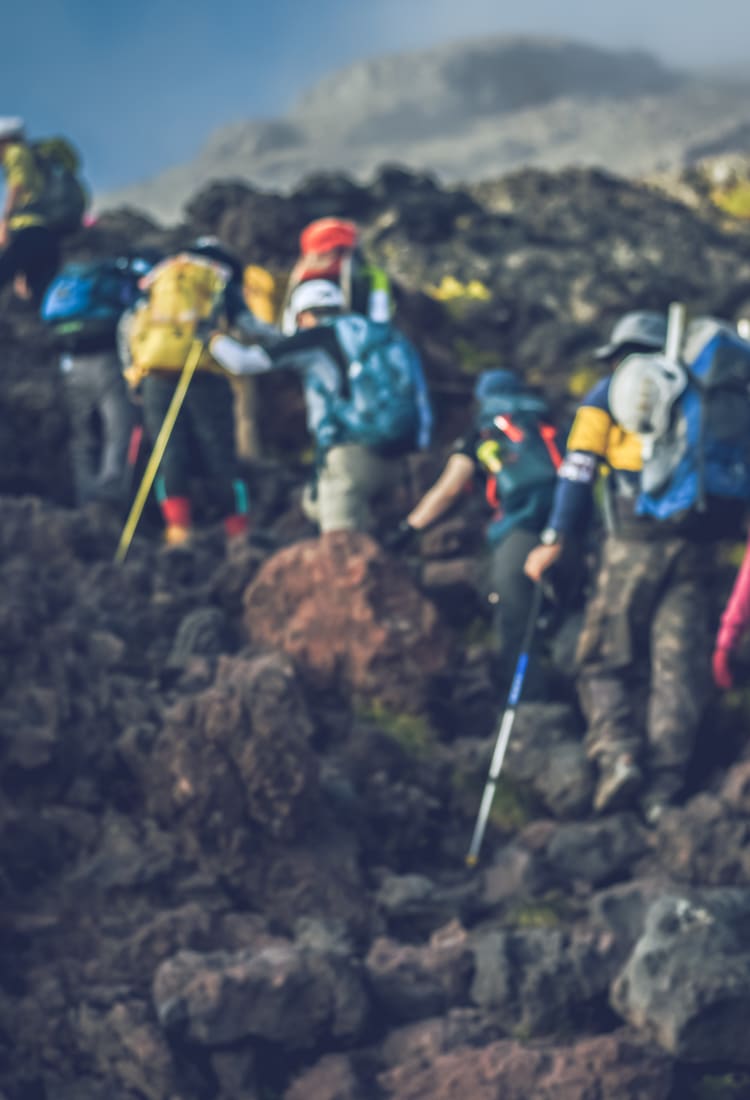Find out everything you need to know about the Fujinomiya Trail before starting your hike up Mt. Fuji
Located higher up the mountain than the 5th Station start points of the other three trails, the Fujinomiya Trail offers the shortest ascent. It gets busy during peak season, but its reputation makes it slightly less popular than the Yoshida Trail.
The Fujinomiya Trail at a glance
Start at Fujinomiya Trail 5th Station, approximately 2,400 meters above sea level
Ascent: 4.3km trail. Approximately five to seven hours. Fair number of facilities available
Descent: 4.3km trail. Approximately two to five hours depending on conditions and congestion
Offers easy access to Mt. Hoei, one of Mt. Fuji's secondary peaks, formed in the last eruption (early 1700s)
Route overview
Fujinomiya is the second most popular route, partly because it's the only trailhead easily accessible from western Japan. Its shorter distance is made up for by the challenging grade of the slope and many areas of rocky terrain. Because of its popularity, there are a good number of mountain huts and facilities available as you make your way up the mountain. Physicians are on hand 24/7 at the 8th station during some of the climbing season too, so you can feel safe and reassured during your ascent.
Starting your trek
The Fujinomiya Trail starts from the Fujinomiya Trail 5th Station. Here you can purchase last minute supplies from one of the shops, use the restroom, and prep yourself for the journey ahead. Stop by the General Information Center to get a map and useful information for your hike up.
Accessing the trailhead
The Fujinomiya Trail 5th Station can be accessed by bus and shuttle from numerous Shizuoka locations and key train stations.
From Mishima Station on the shinkansen line connecting Tokyo and Kyoto, a fixed-route bus departs roughly every two hours from 7:40 a.m. to 4:00 p.m. The trip takes about two hours and costs 3,200 yen round-trip. Reservations are not required.
From Shin-Fuji Station, also on the shinkansen, buses leave for the trailhead every hour, making a stop at Fujinomiya Station. The service starts at 10:00 a.m. (or 8:10 a.m. from Fujinomiya Station), takes roughly two and a half hours and costs 3,200 yen round trip. Buses on this route do not require reservations.
For people wishing to drive, all the roads to the 5th station trailheads are closed to private traffic during the peak climbing season (July to September). To get to Fujinomiya Trail 5th Station by car, you should park at the Mizugazuka parking area and take a shuttle or taxi to the 5th station. The shuttle comes every 60 minutes throughout the day (from 6:00 a.m. to 5:00 p.m.) and costs 2,000 yen round trip. Taxis cost roughly 4,750 yen one way.
The climb
From the 5th station to the summit, expect the climb to take at least five hours. The beginning is a short stretch to the 6th station, where you will find a couple of mountain huts (Unkaiso and Hoeisanso). For people not interested in going all the way to the summit of Mt. Fuji, you can find a shorter hike to Mt. Hoei here. Mt. Hoei was formed during the last major eruption, and on clear days the peak affords panoramic vistas that stretch as far as the Pacific Ocean and even Tokyo. Returning from the peak offers a short sunabashiri (sand run) like is found on the Gotemba Trail.

Assuming you want to continue to the summit of Mt. Fuji, continue up for an hour to the new 7th station. Here you will find the Goraikosanso mountain hut and a more desert-like landscape with little vegetation. From the new to the old 7th station, it will take another 50 minutes. Notice how the terrain starts to take on a reddish-hue as you continue up. Be careful around this point as the trail will narrow and can become congested during peak hours.

After another 40 minutes, you will find yourself at the Ikedakan mountain hut. Take the opportunity for a break, and if you have any health concerns feel free to stop in at the Health Center here, which has physicians on duty 24/7.
After a short break, continue up 30 minutes to the 9th station where you will find the Munatsukisanso hut. Here the trail can be especially busy in the pre-sunrise hours, and it becomes much steeper. It's highly recommended to put on a helmet at this point. You can also see sections of snow just off the trail.
Another 30 minutes will take you to a midway station between the 9th station and the summit, and Munatsukisanso hut. This is the last mountain hut before the summit, so rest up for the last push to the top. At this stage, an elevation increase of 221 meters stands between you and the peak.

Where to Stay
Goraikosanso is located at the new 7th station, roughly 2,780m above sea level. This location offers private and dormitory-style rooms, starting at 6,000 yen per night on weekdays. The hike from here to the summit is roughly three hours, but you can see the sunrise even from the lodge.
If you're looking to get closer to the top before taking a break, why not go all the way? Chojo Fujikan is located at the tenth station, the last and final station at the summit. It is next to the Okumiya of Fujisan Hongu Sengen Taisha postbox (in case you want to send a postcard) and just 8 minutes from Mt Fuji's very highest point. A basic futon set is provided, starting at 6,000 yen with no meals and 8,000 with two meals. You can make reservations by phone, fax or email.




For additional information and alternative lodgings, see the complete list of Fuji mountain huts .
The latest information may differ, so please check the official website






















































